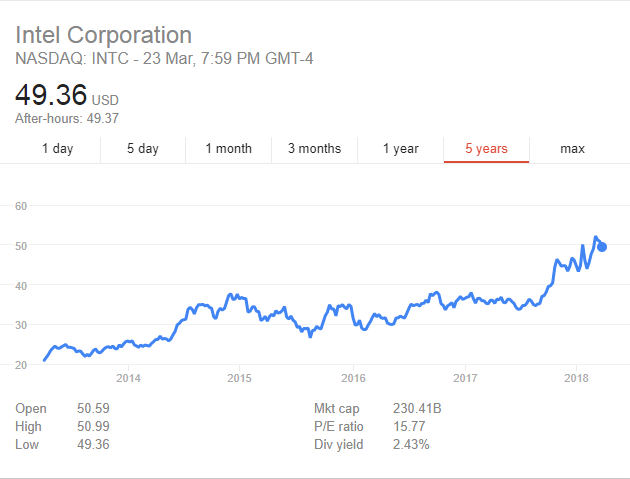Amidst a lackluster stock market, Intel Corporation (NASDAQ: INTC) has been displaying strength enough to attract prospective investors. As of March 25, 2018, the Intel stock is trading 40% up year-to-date with reports of strong chip sales and improvement in the buying ratings by analytical firms.
In Q4 2017, Intel posted its operating income of $5.9bn, the highest ever in over two years. Its non-GAAP EPS was $1.08, which was 36.7% higher than the year-ago quarter. Due to the Republican tax reform, the company incurred a one-time expense of $5.4bn and posted a GAAP loss of 15 cents per share. Revenue for Q4 was $17.2bn (up by 8%) and for the full year was $62.8bn (up by 9%). It generated a cash flow of $22bn and returned $9bn to its shareholders by increasing its dividend by 10% on an annual basis.
How has the stock been performing?

Intel stock has been rallying since the beginning of 2017 with a YTD growth of 44% (as on March 26). The market for computers has been slowing down, however, it has not much impacted Intel as the company is also growing in cloud data centers. The revenue for data centers grew by 21% in Q4 2017.
At the beginning of 2018, the stock dropped by 15% due to security threats and Intel processor bugs (found in chips) which left millions prone to a cyber attack. It led stock prices down to $42. However, its strong quarter Q4 results led the stock up by 15% to $52 in March 2018.
The stock for Intel has been growing after every quarter earnings release leading to a total stock gain in the past few months. Even though the computer market is on a slowdown in the recent years, the laptop market has grown substantially. The growth in the Smart phones industry also helped Intel as mobile devices are also dependent on data centers, and Intel is foraying in this market at a break neck pace. Analysts at Citi Research gave a ‘buy’ rating to the INTC stock expecting the firm to post strong profits in 2018.
Is Intel a healthy Dividend stock?

On March 15, 2018, Intel declared a dividend of $0.30 per share payable on June 1, 2018. The stock has a dividend yield of 2.35% which is greater than S&P 500 yield of 1.78%. In the past five years, Intel’s quarterly dividend rate has grown by 33%. It started paying dividends in 1993 but has not cut the dividend even during the dot-com bubble and the financial crisis. Shareholders have a greater advantage with Intel stock as the dividend hike is accompanied by stock price rise too.
Intel has a cash flow of $22bn and it paid a dividend of $5.1bn in 2017. This gives a payout ratio of 23.1% and leaves room for more dividend hikes in the future. With growing revenues and earnings, shareholders can be sure that the upward momentum will support the stock price rally and discreet investors can lock in capital gains.
Where does Intel Corp stand in the Top 10 stocks of the Dow Jones U.S. Technology Index (DJUSTC)?

